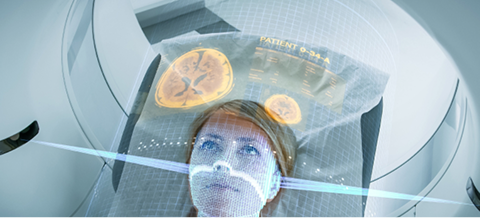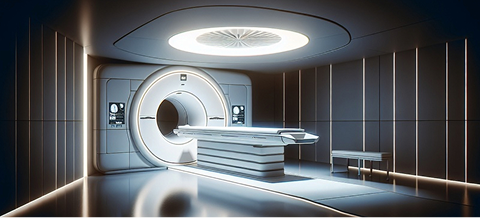Intraoperative MRI (iMRI)
At Burjeel Medical City, we offer both 1.5T and 3T MRI (Magnetic Resonance Imaging) technologies, providing advanced, high-resolution imaging for the diagnosis and monitoring of various medical conditions. MRI is a non-invasive imaging technique that uses powerful magnetic fields and radio waves to produce detailed images of the body's internal structures. Our 3T MRI, with double the magnetic strength of the 1.5T MRI, offers exceptional clarity and precision, allowing for better visualization of small tumors, structural abnormalities, and detailed anatomical features. These advanced MRI technologies are essential for accurate diagnosis, treatment planning, and monitoring across a wide range of medical specialties.
Key Features.
Reduced Scan Times with 3T MRI
The increased magnetic strength of the 3T MRI reduces scan times, improving patient comfort while maintaining image quality. This allows for quicker diagnostic results, which is crucial in fast-paced, time-sensitive medical situations.
Contrast-Enhanced MRI
Involves the use of a contrast agent to highlight blood vessels and enhance the visibility of abnormalities or pathological changes, improving diagnostic accuracy, especially in complex cases.
Diffusion-Weighted Imaging (DWI)
An MRI technique used to detect changes in tissue by measuring the movement of water molecules in cells, which helps identify areas of inflammation, infection, and other tissue changes that may be indicative of disease progression or tumor spread.
Functional MRI (fMRI)
This advanced MRI technique measures brain activity by detecting changes in blood flow, often used for assessing neurological conditions or brain function during surgery or treatment.
Detailed Soft Tissue Imaging
MRI is particularly effective at visualizing soft tissues, such as the brain, liver, prostate, and musculoskeletal tissues, allowing for the accurate detection and staging of a wide variety of conditions.
High-Resolution Imaging
Both 1.5T and 3T MRI provide detailed, high-resolution images, with the 3T MRI offering even greater clarity, making it ideal for detecting small tumors, subtle abnormalities, and fine tissue structures.
Conditions Diagnosed and Monitored with 1.5T and 3T MRI.
These MRI systems are used to diagnose, stage, and monitor a wide range of medical conditions, including:

- Brain disorders (e.g., neurodegenerative diseases, brain injuries)
- Spinal conditions (e.g., spinal cord injuries, herniated discs, spinal tumors)
- Musculoskeletal conditions (e.g., joint issues, ligament tears, bone infections)
- Abdominal and pelvic conditions (e.g., liver disease, gallbladder issues, kidney disorders)
- Gynecological conditions (e.g., fibroids, ovarian cysts)
- Cardiovascular conditions (e.g., heart disease, vascular abnormalities)
- Lung diseases (e.g., pneumonia, pulmonary embolism)
Benefits of 1.5T and 3T MRI.
Both 1.5T and 3T MRI systems provide a range of benefits for patients:

Superior Soft Tissue Contrast
MRI offers unparalleled imaging of soft tissues, making it ideal for detecting issues in the brain, spine, liver, and other organs where precision is critical for diagnosis and treatment.
Non-Invasive
MRI scans are non-invasive and do not use ionizing radiation, making them a safe option for diagnosis and follow-up imaging, without the risks associated with other imaging methods.
Detailed Imaging for Treatment Planning
The high-resolution images produced by MRI help guide treatment decisions, such as surgical planning, radiation therapy, or interventional procedures, ensuring precise treatment targeting.
Detection of Small Tumors and Abnormalities
The 3T MRI is particularly effective at detecting small tumors or abnormalities that may be difficult to see on other imaging modalities, ensuring earlier diagnosis and intervention.
Functional Imaging Capabilities
Functional MRI and diffusion-weighted imaging help evaluate brain function, tumor aggressiveness, and monitor the response to treatment, as well as detect tumor recurrence.
Contrast-Enhanced Scanning
The use of contrast agents in MRI can enhance the visibility of blood vessels, tumors, and abnormal tissues, improving diagnostic accuracy and allowing for clearer images of affected areas.
Our Approach to MRI Imaging.
At Burjeel Medical City, our MRI imaging services are part of a comprehensive, patient-centered approach to healthcare:

Multidisciplinary Collaboration6
Our radiologists, medical specialists, and surgeons collaborate closely to interpret MRI results and develop personalized treatment plans for each patient. This teamwork ensures that imaging plays a vital role in guiding treatment decisions.
Personalized Imaging Protocols
We tailor MRI protocols to the specific needs of each patient, ensuring that the scans provide the necessary information for accurate diagnosis and treatment planning.
Advanced Technology
Our 3T MRI system offers the latest advancements in imaging, ensuring the highest level of accuracy for diagnosis, monitoring, and treatment planning.
Focus on Comfort and Efficiency
Our MRI systems are designed to provide a comfortable scanning experience, with reduced scan times and minimized patient discomfort, especially with the 3T MRI, allowing for quick and efficient diagnostic procedures.
Patient Journey.
Patients undergoing MRI imaging at Burjeel Medical City can expect a supportive and efficient experience:
-

Initial Consultation
A consultation with a physician to determine the most appropriate imaging study based on the patient's medical condition and diagnostic needs.
-

Imaging Preparation
Patients are guided through the MRI preparation process, which may involve the use of a contrast agent to enhance image quality and provide clearer views of the tissues.
-

MRI Scan
The MRI scan is conducted in a comfortable environment, with patients lying still while the imaging system captures detailed images of the targeted area.
-

Image Analysis
The MRI images are reviewed by a specialized team, and a comprehensive report is provided to the patient's care team for diagnosis and treatment planning.
-

Post-Imaging Follow-Up
After the scan, the patient will receive feedback on the results and discuss any changes to their treatment plan, with follow-up scans scheduled as needed to monitor progress.